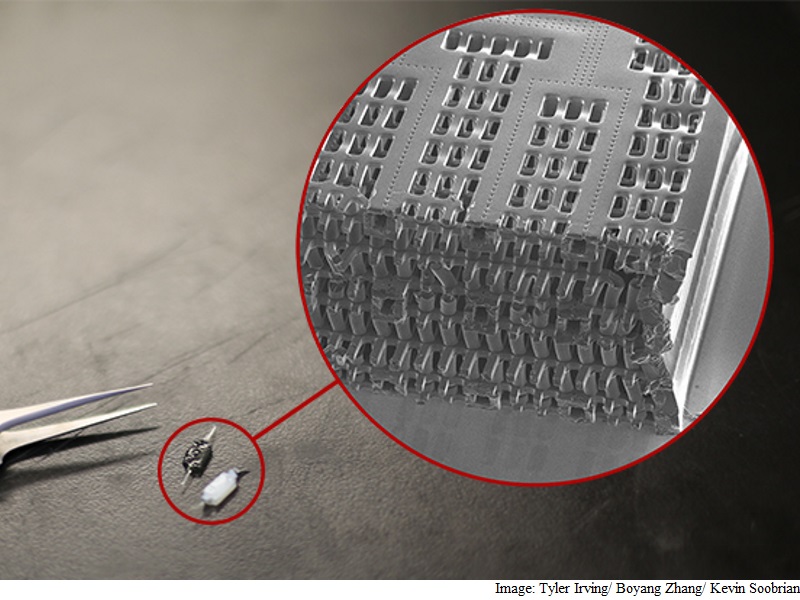- Home
- Science
- Science News
- Person on a Chip Tech May Help Repair Damaged Organs: Study
Person-on-a-Chip Tech May Help Repair Damaged Organs: Study

Researchers from the University of Toronto built model versions of both heart and liver tissues that function like real organs, using the new technology called AngioChip, a powerful platform for discovering and testing new drugs.
"Our liver actually produced urea and metabolised drugs," said Professor Milica Radisic.
Using the platform, they can connect the blood vessels of the two artificial organs, thereby modelling not just the organs themselves, but the interactions between them.
They have even injected white blood cells into the vessels and watched as they squeezed through gaps in the vessel wall to reach the tissue on the other side, just as they do in the human body.
The researchers wanted to find ways to grow human tissues in the lab, under conditions that mimic a real person's body.
They developed unique methods for manufacturing small, intricate scaffolds for individual cells to grow on.
These artificial environments produce cells and tissues that resemble the real thing more closely than those grown lying flat in a petri dish.
"It's a fully three-dimensional structure complete with internal blood vessels. It behaves just like vasculature, and around it there is a lattice for other cells to attach and grow," said Radisic.
The scaffold is built out of a series of thin layers of a biodegradable and biocompatible polymer POMaC, stamped with a pattern of channels that are about 50 to 100 micrometres wide. The layers, which resemble the computer microchips, are then stacked into a 3D structure of synthetic blood vessels.
As each layer is added, ultra-violet (UV) light is used to cross-link the polymer and bond it to the layer below.
When the structure is finished, it is bathed in a liquid containing living cells. The cells quickly attach to the inside and outside of the channels and begin growing just as they would in the human body, researchers said.
"In the last few years, it has become possible to order cultures of human cells for testing, but they're grown on a plate, a two-dimensional environment," said Radisic.
"They don't capture all the functional hallmarks of a real heart muscle, for example," she said.
A platform AngioChip could enable drug companies to detect dangerous side effects and interactions between organs. In future the lab-grown tissues could even be implanted into the body to repair organs damaged by disease.
The team has shown that the AngioChip can be implanted into a living animal, its artificial blood vessels connected to a real circulatory system. The polymer scaffolding itself biodegrades after several months.
The study was published in the journal Nature Materials.
Catch the latest from the Consumer Electronics Show on Gadgets 360, at our CES 2026 hub.
Related Stories
- Samsung Galaxy Unpacked 2025
- ChatGPT
- Redmi Note 14 Pro+
- iPhone 16
- Apple Vision Pro
- Oneplus 12
- OnePlus Nord CE 3 Lite 5G
- iPhone 13
- Xiaomi 14 Pro
- Oppo Find N3
- Tecno Spark Go (2023)
- Realme V30
- Best Phones Under 25000
- Samsung Galaxy S24 Series
- Cryptocurrency
- iQoo 12
- Samsung Galaxy S24 Ultra
- Giottus
- Samsung Galaxy Z Flip 5
- Apple 'Scary Fast'
- Housefull 5
- GoPro Hero 12 Black Review
- Invincible Season 2
- JioGlass
- HD Ready TV
- Laptop Under 50000
- Smartwatch Under 10000
- Latest Mobile Phones
- Compare Phones
- OPPO Reno 15 Pro Max
- Honor Win RT
- Honor Win
- Xiaomi 17 Ultra Leica Edition
- Xiaomi 17 Ultra
- Huawei Nova 15
- Huawei Nova 15 Pro
- Huawei Nova 15 Ultra
- Asus ProArt P16
- MacBook Pro 14-inch (M5, 2025)
- OPPO Pad Air 5
- Huawei MatePad 11.5 (2026)
- Xiaomi Watch 5
- Huawei Watch 10th Anniversary Edition
- Acerpure Nitro Z Series 100-inch QLED TV
- Samsung 43 Inch LED Ultra HD (4K) Smart TV (UA43UE81AFULXL)
- Asus ROG Ally
- Nintendo Switch Lite
- Haier 1.6 Ton 5 Star Inverter Split AC (HSU19G-MZAID5BN-INV)
- Haier 1.6 Ton 5 Star Inverter Split AC (HSU19G-MZAIM5BN-INV)

















